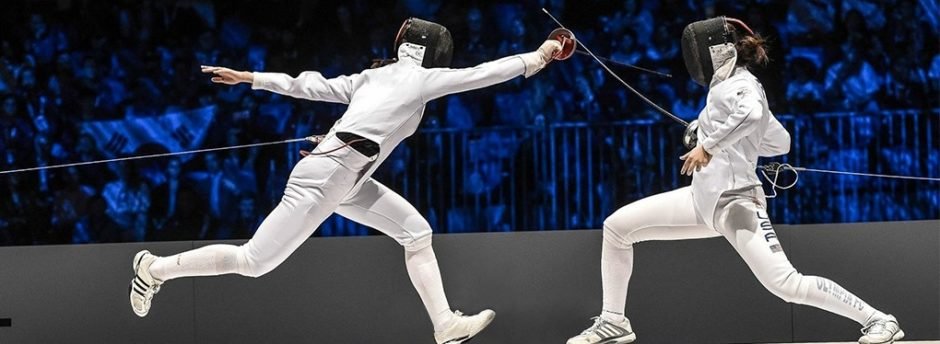Protective Clothing
Fencing outfits are made of tough cotton or nylon. Kevlar was added to top level uniform pieces (jacket, breeches, underarm protector, lamé, and the bib of the mask) following the Smirnov incident at the 1982 World Championships in Rome. However, kevlar breaks down in chlorine and UV light, complicating the cleaning process.

In recent years other ballistic fabrics such as Dyneema have been developed that resist puncture and which do not have kevlar’s issues. FIE rules state that the tournament outfits must be made of fabric that resists a force of 800 newtons (180 lbf) and that the mask bib must resist double that amount. The complete fencing kit includes: Form-fitting jacket covering groin with strap (croissard) which goes between the legs. In sabre fencing, jackets that are cut along the waist and exclude the groin padding are sometimes used. A small gorget of folded fabric is sewn in around the collar to prevent an opponent’s blade from slipping under the mask and along the jacket upwards towards the neck. Plastron, an underarm protector, which goes underneath the jacket and provides double protection on the sword arm side and upper arm. The armpit cannot have a seam, which would line up with the jacket seam and provide a weak spot. One glove for the weapon arm with a gauntlet that prevents blades from going up the sleeve and causing injury, as well as protecting the hand and providing a good grip. Breeches or knickers which are a pair of short trousers that end just below the knee. The breeches are required to have 10 cm of overlap with the jacket. Most are equipped with suspenders.Chest protector (women’s). Knee-length or thigh high socks which cover knee and thighs. Shoes with flat soles and reinforcement on the inside of the back foot and heel of front foot, to prevent wear from lunging. Mask, including a bib which protects the neck. The mask can usually support 12 kilograms (26 lb) on the metal mesh 350 newtons (79 lbf) of penetration resistance on the bib. FIE regulations dictate that masks must withstand 25 kilograms (55 lb) on the mesh and 1,600 newtons (360 lbf) on the bib. Some modern masks have a see-through visor in the front of the mask. These have been used at high level competitions (World Championships etc.), however, they are currently banned by the FIE, following a 2009 incident in which a visor was pierced during the European Junior Championship competition. Plastic chest protector, mandatory for females. While male versions of the chest protector are also available, they were, until recently, primarily worn by instructors, who are hit far more often during training than their students. These are increasingly popular in foil, as the hard surface increases the likelihood that a hit fails to register, as well as with youth competitors. Lamé is a layer of electrically conductive material worn over the fencing jacket that entirely covers the valid target area. It is worn only in foil and sabre, and serves to distinguish hits on target from those that are off-target. In epee, the entire body is target, so it is not necessary to have a lamé. In foil the lamé is sleeveless, while in sabre the lamé has sleeves and ends in a straight line across the waist. A body cord is necessary to register scoring: it attaches to the weapon and runs inside the jacket sleeve, then down the back and out to the scoring box. In sabre and foil the body cord connects to the lamé in order to create a circuit to the scoring box. Fencing Masters often choose a heavier protective jacket, usually reinforced by plastic foam to cushion the numerous hits an instructor has to endure. Sometimes in practice, masters wear a protective sleeve or a leg leather to protect their fencing arm or leg. Traditionally, the fencers’ uniform is white (black for instructors). This may be due to the occasional pre-electric practice of covering the point of the weapon in dye, soot, or colored chalk in order to make it easier for the referee to determine the placing of the touches. As this is no longer a factor in electric Recently the FIE rules have been relaxed to allow colored uniforms (save black). The guidelines also limit the permitted size and positioning of sponsorship logos.
